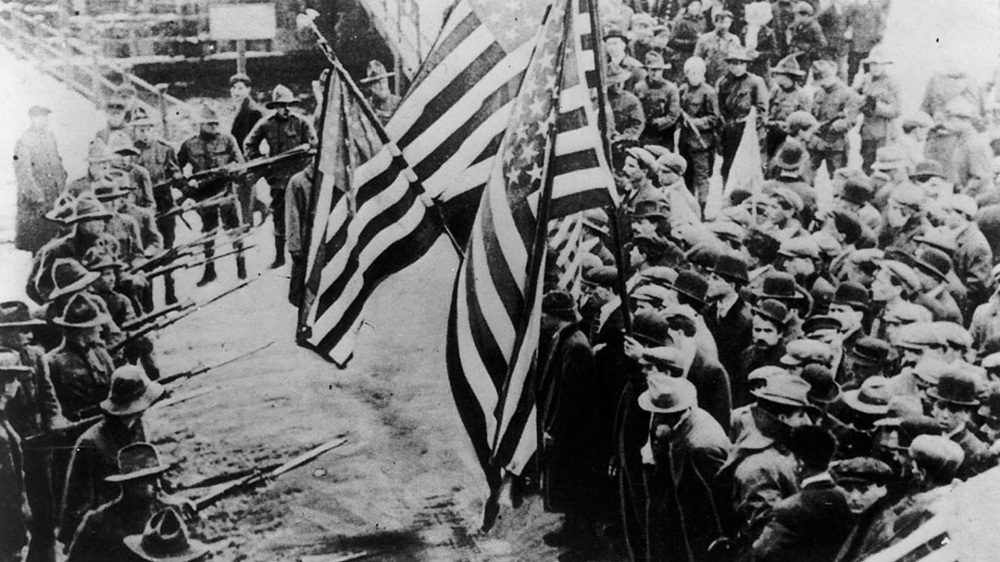
Friedrich Graetz, “The Tournament of Today – A Set-To Between Labor and Monopoly.” August 1, 1883. Library of Congress (LC-DIG-ppmsca-28412).
Introduction
Industrialization remade the United States. At the turn of the twentieth century, powerful capitalists, middle class managers, and industrial and agricultural labors confronted a new world of work and labor in the United States. While many benefited from the material gains of technological progress, others found themselves trapped in cycles of poverty and hopelessness and strikes, protests, and political warfare rocked American life as workers adjusted themselves to a new industrial order. The following sources explore the mindsets of American suddenly confronted with a new world of concentrated capital and industrial labor.
Documents
1. William Graham Sumner on Social Darwinism (ca.1880s)
William Graham Sumner, a sociologist at Yale University, penned several pieces associated with the philosophy of Social Darwinism. In the following, Sumner explains his vision of nature and liberty in a just society.
2. Henry George, Progress and Poverty, Selections (1879)
In 1879, the economist Henry George penned a massive bestseller exploring the contradictory rise of both rapid economic growth and crippling poverty.
3. Andrew Carnegie’s Gospel of Wealth (1889)
Andrew Carnegie, the American steel titan, explains his vision for the proper role of wealth in American society.
4. Grover Cleveland’s Veto of the Texas Seed Bill (1887)
Amid a crushing drought that devastated many Texas farmers, Grover Cleveland vetoed a bill designed to help farmers recover by supplying them with seed. In his veto message, Cleveland explained his vision of proper government.
5. The “Omaha Platform” of the People’s Party (1892)
In 1892, the People’s, or Populist, Party crafted a platform that indicted the corruptions of the Gilded Age and promised government policies to aid “the people.”
6. Dispatch from a Mississippi Colored Farmers’ Alliance (1889)
The Colored Farmers’ Alliance, an African American alternative to the whites-only Southern Farmers’ Alliance, organized as many as a million Black southerners against the injustices of the predominately cotton-based, southern agricultural economy. Black Populists, however, were always more vulnerable to the violence of white southern conservatives than their white counterparts. Here, the publication The Forum publishes an account of violence against Black Populists in Mississippi.
7. Lucy Parsons on Women and Revolutionary Socialism (1905)
Lucy Parsons was born into slavery in Texas, married a white radical, Albert Parsons, and moved to Chicago where they both worked on behalf of radical causes. After Albert Parsons was executed for conspiracy in the aftermath of the Haymarket bombing, Lucy Parsons emerged as a major American radical and vocal advocate of anarchism. In 1905, she spoke before the founding convention of the Industrial Workers of the World (IWW).
Media
“The Tournament of Today” (1883)
![Friedrich Graetz, “The Tournament of Today - A Set-To Between Labor and Monopoly.” August 1, 1883. Print shows a jousting tournament between an oversized knight riding horse-shaped armor labeled "Monopoly" over a locomotive, with a long plume labeled "Arrogance", and carrying a shield labeled "Corruption of the Legislature" and a lance labeled "Subsidized Press", and a barefoot man labeled "Labor" riding an emaciated horse labeled "Poverty", and carrying a sledgehammer labeled "Strike". On the left is seating "Reserved for Capitalists" where Cyrus W. Field, William H. Vanderbilt, John Roach, Jay Gould, and Russell Sage are sitting. On the right, behind the labor section, are telegraph lines flying monopoly banners that are labeled "Wall St., W.U.T. Co., [and] N.Y.C. RR". Via Library of Congress (LC-DIG-ppmsca-28412).](http://www.americanyawp.com/reader/wp-content/uploads/The-tournament-of-today-a-set-to-between-labor-and-monopoly-1000x563.jpg)
Friedrich Graetz, “The Tournament of Today – A Set-To Between Labor and Monopoly.” August 1, 1883. Via Library of Congress (LC-DIG-ppmsca-28412).
Lawrence Textile Strike (1912)
In 1912, The International Workers of the World (the IWW, or the “Wobblies”) organized textile workers in Lawrence and Lowell, Massachusetts. This photo shows strikers, carrying American flags, confronting strikebreakers and militia bayonets.
